Classic wood hot tubs hold a special appeal. Their roots span the globe, from the soaking tubs of Japan to the heated baths and steam rooms found throughout the rest of the world. Though not as ubiquitous as they once were, wood hot tubs are still the top choice for many who are looking for a simple way to unwind at home.
Here’s what to know about adding a wood soaking tub to your yard — including tips for choosing a hot tub, care instructions and whom to hire.
Howells Architecture + Design
A classic wood hot tub is the perfect spot for relaxing, refreshing your body and mind, socializing and taking in the nature around you in a calm, serene setting. It resonates with those who appreciate the simple design and organic look and feel.
“I use these tubs because I find them more humane and naturalistic than the much more common molded plastic options,” says architect Michael Howells of Howells Architecture + Design in Portland, Oregon. He adds that the dark finish and lack of an interior light allow the water to read as much darker and more like it is in nature. “They are more pond-like…simple and reductive,” he says.
Though hot tubs are, by definition, filled with hot water, it’s not a requirement. Many people transform their hot tubs to “cool” tubs by not heating the water and instead enjoying the cooler water temperature on hot summer days. If you want it even colder, you can add a chiller element.
Artisans Landscape Inc
Whom to Hire
Check with your hot tub supplier about installation requirements. You’ll need a professional to install any plumbing or electrical lines.
Expert do-it-yourselfers with handy friends may be able to do the rest, especially if the tub is delivered prebuilt. Otherwise, check into contractors that can help, especially if the tub will need to be assembled on-site. Your manufacturer can provide more guidance.
Find a contractor in your area
Holly Lepere - Lepere Studio, Photographer
Hot Tub Basics
Traditional wood tubs are deep tubs that are lined with seats around the inner perimeter. The depth allows you to relax in shoulder-height water, which increases your sense of buoyancy and weightlessness; the seats keep you at a comfortable height. They’re generally smaller than acrylic spas, without as many bells and whistles.
Aquatica Plumbing Group
Size and shape. How big your tub will be and what it will look like will be your first decisions. Hot tubs come in a variety of sizes, from cozy versions designed for one or two people to those that can hold up to eight people.
A round tub isn’t your only choice — you can also find tubs that are oval or rectangular. The design is based on the design of ofuros, the traditional soaking tubs found in Japan. “It is traditionally a tongue-and-groove wooden tub that has no fasteners or adhesive to hold the vertical planks together, but instead uses two steel straps that are tightened,” says architect Amy Lopez-Cepero of Ampersand Architecture in New York.
Gardens by Gabriel, Inc.
Material. Today’s wood hot tubs are generally made of cedar or teak, rather than the redwood or oak that was previously used. Both types of wood are more durable and less prone to leaking. You can let the wood weather to a soft gray or stain or seal it to keep the original color.
Swick's Organic Landscaping
Heat source. Choosing a heat source is the next step. Electricity is the most popular heating option. It’s both easy to set up and has the lowest start-up costs. Gas, whether from a propane tank or a natural gas line, is also fairly straightforward, although the start-up costs are higher. If you opt for a tank, be sure you can easily reach it when it’s time to replace it. A gas-and-electric hybrid heat source is another option.
PARASHOOT architects
You can also consider a wood-fired heating system. This requires more prep time to start the fire, and you’ll also need to clean up afterward. It’s a good choice if you’re in a remote area or if you are simply looking for a traditional heat source.
Along with the heat source, you’ll need a pump, a filter and any connections for plumbing and electricity.
Cummings Landscape Architecture
Cover. A cover for the tub is also a priority. Safety is your first concern, but a cover also holds in the heat and keeps out debris. You’ll find a variety of options to fit your personal style, including wood, aluminum, vinyl and similar materials. Thermal or insulated covers are best for holding in the heat and are recommended for cold-winter climates.
Wood and aluminum covers are lifted directly off the tub and set aside. Before you invest in one, check the weight to be sure you can easily move it — wood, especially, can be bulky and heavy. Vinyl covers can be lifted off or rolled back, much like a swimming pool cover.
Mission Valley Spas
Bonus features. Wood hot tubs generally have far fewer bells and whistles than acrylic or fiberglass spas, as mentioned, but that doesn’t mean you can’t deck them out. A simple but useful addition is a ledge that encircles part of the tub, making a great spot for drinks or snacks.
You can also find small jets to add to your tub. You won’t get the bubbles of a spa, but they will aerate the water. For added convenience, look for a control with a Wi-Fi connection so you can make adjustments without getting out of the tub.
Ampersand Architecture
While you’re enjoying the distant view, such as this one from the rooftop of a New York City loft, you can also take in the sights closer to the tub. Great plantings, soft lights or a nearby fire pit can add to the ambiance, as can a TV for watching the game — or watching nature that’s a bit farther away.
Shop for outdoor lighting on Houzz
Margie Grace - Grace Design Associates
Planning and Installation Basics
Once you’ve decided on your hot tub, the next step is deciding where it will go. You’ll also need to prepare the site for the tub and its accessories.
Where it will go. Hot tubs are remarkably versatile when it comes to where to put them. The ideal spot for a hot tub is one where the surroundings and views are equally relaxing.
Think about when and how you plan to use the tub. Should it be close to the house so it’s easy to get to it and back? The nearness also might tempt you to use it more often. Do you envision it right outside your bedroom for an evening or early morning dip away from the rest of the household? Perhaps you want it set far out in the yard, whether to let you take in the surrounding landscape or create a true getaway spot.
If privacy is a concern, look for ways of screening the tub. Shrubs, trees or other plantings create a natural look. Walls, screens or a partial shelter can also provide privacy.
Wherever you put it, remember that even the smallest hot tub holds a large amount of water, which is heavy. You’ll want a sturdy, level base that can withstand the elements.
A concrete base is a good choice for most installations. If you don’t want concrete or another type of permanent, solid base, place the tub on a level, flat surface covered with a base of sand or fine gravel to prevent rot.
Stand-alone or submerged? Once you’ve found the right spot, decide how you want to incorporate your tub into the surrounding space. Stand-alone tubs sit fully above the surface, whether it’s the ground, a patio or a deck. This makes installing them fairly straightforward.
You’ll also need to add a way to get in and out of the tub easily and safely. You can add steps that either sit directly against the tub or partially encircle it. The seating inside the tub will also serve as a step. If the tub is particularly deep, you may want to add extra support, such as a handhold, to make it easier to get in and out.
The edge of a completely submerged hot tub is even with the deck, patio or ground. The surrounding surface gives you plenty of space for setting towels, drinks and snacks, and it’s easy to converse with those around you. You’ll need to be sure the cover is secure and sturdy enough to handle any unexpected weight.
A partially submerged hot tub sits slightly above the surrounding surface. A good maximum height is about 18 inches above the ground. More than that and you’ll probably need to add steps.
A hot tub set directly into the ground has extra requirements. For the tub seen here, that meant adding materials to separate the tub from the surrounding soil. “We rolled a piece of steel so that the hot tub would look as if it was in the ground but no direct soil was put up against the hot tub,” says Jayson King, principal designer of Landform Design Group in Salt Lake City. “We also set the hot tub on 6 inches of compacted base so it was structural and not sinking.”
One popular approach is to set half the hot tub at deck level at the edge of a raised patio or deck and extend it out. This allows people to easily access the hot tub from one side and plays up the views of the yard and beyond.
Mechanical equipment. Plan for where the mechanical equipment will go and if you want to disguise it with a cover or by building it into any steps or ledges. Another consideration is any pipes. “If you don’t enclose a portion of the tub, you are going to be looking at PVC piping entering the side wall at one side,” Howells says.
Care and Maintenance
Even the simplest hot tub needs some maintenance to keep it looking good and the water in it clean and fresh. Your hot tub supplier will have specific recommendations, but here are some basic guidelines.
Inside the tub. The first step is to avoid debris with a cover and filter. Taking a quick shower before you enter the tub or having a foot bath nearby can also eliminate a lot of dirt, debris and bacteria.
You’ll find eco-friendly and nontoxic sanitization options such as specialty hydrogen peroxide solutions and ozone sanitizers. You can also find test strips to check levels weekly. Wipe off any dirt on exposed surfaces with soapy water and a soft brush, and wipe off the ends of pipes every week or so.
Outside the tub. Wipe off any dirt with a mild soap solution and a soft brush, and make any repairs as soon as you notice a problem. If you’ve added a stain to your tub, you will need to renew that periodically.
Water replacement. You don’t have to replace the water every time you use the tub, but you will need to do it on a regular basis. Much will depend on how often you use the tub and how clean the water stays. If you soak often, you might want to drain every six to 10 weeks. With less use, every four to six months might be enough.
Using eco-friendly care products lets you recycle the water. You can use it for ornamental landscapes, but do not use it for edible gardens. Another option is to tie the hot tub into your underground drainage system, especially if it is part of a new landscape installation.
Hot tubs are designed to be always filled with water, but you may want to forgo the tub in winter, depending on how extreme your climate is or if it’s at a vacation home you don’t use in winter. If this is the case, drain the tub and then follow the manufacturer’s directions for winterizing it.
Other Considerations for Adding a Wood Hot Tub
When to do this project. When you can add a hot tub depends on your weather. Those in warm-winter climates can usually add one year-round. Where it is colder, you’ll need to wait until the prep work can be done.
How long it will take. Give enough time for a professional to install any new plumbing or electrical lines before you begin installing the tub. You’ll also need to ensure you have a solid base in place before you begin.
It may take as little as a weekend or up to a week to have your hot tub ready to go. If the installation is simple, you won’t need too much time, especially if you don’t need to put the tub together. More complicated installations, especially if you’re adding features or the tub is part of a bigger project, may take longer.
Rules and regulations. It’s always wise to check your local building codes and any homeowners association regulations before you start any landscaping project, including installing a hot tub. There may be requirements for placement or security as well as other considerations.
Classic wood hot tubs hold a special appeal. Their roots span the globe, from the soaking tubs of Japan to the heated baths and steam rooms found throughout the rest of the world. Though not as ubiquitous as they once were, wood hot tubs are still the top choice for many who are looking for a simple way to unwind at home.
Here’s what to know about adding a wood soaking tub to your yard — including tips for choosing a hot tub, care instructions and whom to hire.
A classic wood hot tub is the perfect spot for relaxing, refreshing your body and mind, socializing and taking in the nature around you in a calm, serene setting. It resonates with those who appreciate the simple design and organic look and feel.
“I use these tubs because I find them more humane and naturalistic than the much more common molded plastic options,” says architect Michael Howells of
Howells Architecture + Design in Portland, Oregon. He adds that the dark finish and lack of an interior light allow the water to read as much darker and more like it is in nature. “They are more pond-like…simple and reductive,” he says.
Though hot tubs are, by definition, filled with hot water, it’s not a requirement. Many people transform their hot tubs to “cool” tubs by not heating the water and instead enjoying the cooler water temperature on hot summer days. If you want it even colder, you can add a chiller element.
Whom to HireCheck with your hot tub supplier about installation requirements. You’ll need a professional to install any plumbing or electrical lines.
Expert do-it-yourselfers with handy friends may be able to do the rest, especially if the tub is delivered prebuilt. Otherwise, check into contractors that can help, especially if the tub will need to be assembled on-site. Your manufacturer can provide more guidance.
Find a contractor in your area
Hot Tub Basics
Traditional wood tubs are deep tubs that are lined with seats around the inner perimeter. The depth allows you to relax in shoulder-height water, which increases your sense of buoyancy and weightlessness; the seats keep you at a comfortable height. They’re generally smaller than acrylic spas, without as many bells and whistles.
Size and shape. How big your tub will be and what it will look like will be your first decisions. Hot tubs come in a variety of sizes, from cozy versions designed for one or two people to those that can hold up to eight people.
A round tub isn’t your only choice — you can also find tubs that are oval or rectangular. The design is based on the design of
ofuros, the traditional soaking tubs found in Japan. “It is traditionally a tongue-and-groove wooden tub that has no fasteners or adhesive to hold the vertical planks together, but instead uses two steel straps that are tightened,” says architect Amy Lopez-Cepero of
Ampersand Architecture in New York.
Material. Today’s wood hot tubs are generally made of cedar or teak, rather than the redwood or oak that was previously used. Both types of wood are more durable and less prone to leaking. You can let the wood weather to a soft gray or stain or seal it to keep the original color.
Heat source. Choosing a heat source is the next step. Electricity is the most popular heating option. It’s both easy to set up and has the lowest start-up costs. Gas, whether from a propane tank or a natural gas line, is also fairly straightforward, although the start-up costs are higher. If you opt for a tank, be sure you can easily reach it when it’s time to replace it. A gas-and-electric hybrid heat source is another option.
You can also consider a wood-fired heating system. This requires more prep time to start the fire, and you’ll also need to clean up afterward. It’s a good choice if you’re in a remote area or if you are simply looking for a traditional heat source.
Along with the heat source, you’ll need a pump, a filter and any connections for plumbing and electricity.
Cover. A cover for the tub is also a priority. Safety is your first concern, but a cover also holds in the heat and keeps out debris. You’ll find a variety of options to fit your personal style, including wood, aluminum, vinyl and similar materials. Thermal or insulated covers are best for holding in the heat and are recommended for cold-winter climates.
Wood and aluminum covers are lifted directly off the tub and set aside. Before you invest in one, check the weight to be sure you can easily move it — wood, especially, can be bulky and heavy. Vinyl covers can be lifted off or rolled back, much like a swimming pool cover.
Bonus features. Wood hot tubs generally have far fewer bells and whistles than acrylic or fiberglass spas, as mentioned, but that doesn’t mean you can’t deck them out. A simple but useful addition is a ledge that encircles part of the tub, making a great spot for drinks or snacks.
You can also find small jets to add to your tub. You won’t get the bubbles of a spa, but they will aerate the water. For added convenience, look for a control with a Wi-Fi connection so you can make adjustments without getting out of the tub.
While you’re enjoying the distant view, such as this one from the rooftop of a New York City loft, you can also take in the sights closer to the tub. Great plantings, soft lights or a nearby fire pit can add to the ambiance, as can a TV for watching the game — or watching nature that’s a bit farther away.
Shop for outdoor lighting on Houzz
Planning and Installation Basics
Once you’ve decided on your hot tub, the next step is deciding where it will go. You’ll also need to prepare the site for the tub and its accessories.
Where it will go. Hot tubs are remarkably versatile when it comes to where to put them. The ideal spot for a hot tub is one where the surroundings and views are equally relaxing.
Think about when and how you plan to use the tub. Should it be close to the house so it’s easy to get to it and back? The nearness also might tempt you to use it more often. Do you envision it right outside your bedroom for an evening or early morning dip away from the rest of the household? Perhaps you want it set far out in the yard, whether to let you take in the surrounding landscape or create a true getaway spot.
Wherever you put it, remember that even the smallest hot tub holds a large amount of water, which is heavy. You’ll want a sturdy, level base that can withstand the elements.
A concrete base is a good choice for most installations. If you don’t want concrete or another type of permanent, solid base, place the tub on a level, flat surface covered with a base of sand or fine gravel to prevent rot.
Stand-alone or submerged? Once you’ve found the right spot, decide how you want to incorporate your tub into the surrounding space. Stand-alone tubs sit fully above the surface, whether it’s the ground, a patio or a deck. This makes installing them fairly straightforward.
You’ll also need to add a way to get in and out of the tub easily and safely. You can add steps that either sit directly against the tub or partially encircle it. The seating inside the tub will also serve as a step. If the tub is particularly deep, you may want to add extra support, such as a handhold, to make it easier to get in and out.
The edge of a completely submerged hot tub is even with the deck, patio or ground. The surrounding surface gives you plenty of space for setting towels, drinks and snacks, and it’s easy to converse with those around you. You’ll need to be sure the cover is secure and sturdy enough to handle any unexpected weight.
A partially submerged hot tub sits slightly above the surrounding surface. A good maximum height is about 18 inches above the ground. More than that and you’ll probably need to add steps.
A hot tub set directly into the ground has extra requirements. For the tub seen here, that meant adding materials to separate the tub from the surrounding soil. “We rolled a piece of steel so that the hot tub would look as if it was in the ground but no direct soil was put up against the hot tub,” says Jayson King, principal designer of
Landform Design Group in Salt Lake City. “We also set the hot tub on 6 inches of compacted base so it was structural and not sinking.”
One popular approach is to set half the hot tub at deck level at the edge of a raised patio or deck and extend it out. This allows people to easily access the hot tub from one side and plays up the views of the yard and beyond.
Mechanical equipment. Plan for where the mechanical equipment will go and if you want to disguise it with a cover or by building it into any steps or ledges. Another consideration is any pipes. “If you don’t enclose a portion of the tub, you are going to be looking at PVC piping entering the side wall at one side,” Howells says.
Care and Maintenance
Even the simplest hot tub needs some maintenance to keep it looking good and the water in it clean and fresh. Your hot tub supplier will have specific recommendations, but here are some basic guidelines.
Inside the tub. The first step is to avoid debris with a cover and filter. Taking a quick shower before you enter the tub or having a foot bath nearby can also eliminate a lot of dirt, debris and bacteria.
You’ll find eco-friendly and nontoxic sanitization options such as specialty hydrogen peroxide solutions and ozone sanitizers. You can also find test strips to check levels weekly. Wipe off any dirt on exposed surfaces with soapy water and a soft brush, and wipe off the ends of pipes every week or so.
Outside the tub. Wipe off any dirt with a mild soap solution and a soft brush, and make any repairs as soon as you notice a problem. If you’ve added a stain to your tub, you will need to renew that periodically.
Water replacement. You don’t have to replace the water every time you use the tub, but you will need to do it on a regular basis. Much will depend on how often you use the tub and how clean the water stays. If you soak often, you might want to drain every six to 10 weeks. With less use, every four to six months might be enough.
Using eco-friendly care products lets you recycle the water. You can use it for ornamental landscapes, but do not use it for edible gardens. Another option is to tie the hot tub into your underground drainage system, especially if it is part of a new landscape installation.
Hot tubs are designed to be always filled with water, but you may want to forgo the tub in winter, depending on how extreme your climate is or if it’s at a vacation home you don’t use in winter. If this is the case, drain the tub and then follow the manufacturer’s directions for winterizing it.
Other Considerations for Adding a Wood Hot Tub
When to do this project. When you can add a hot tub depends on your weather. Those in warm-winter climates can usually add one year-round. Where it is colder, you’ll need to wait until the prep work can be done.
How long it will take. Give enough time for a professional to install any new plumbing or electrical lines before you begin installing the tub. You’ll also need to ensure you have a solid base in place before you begin.
It may take as little as a weekend or up to a week to have your hot tub ready to go. If the installation is simple, you won’t need too much time, especially if you don’t need to put the tub together. More complicated installations, especially if you’re adding features or the tub is part of a bigger project, may take longer.
Rules and regulations. It’s always wise to check your local building codes and any homeowners association regulations before you start any landscaping project, including installing a hot tub. There may be requirements for placement or security as well as other considerations.
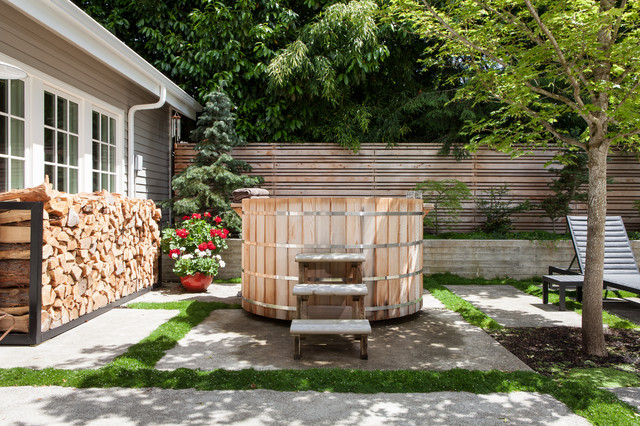

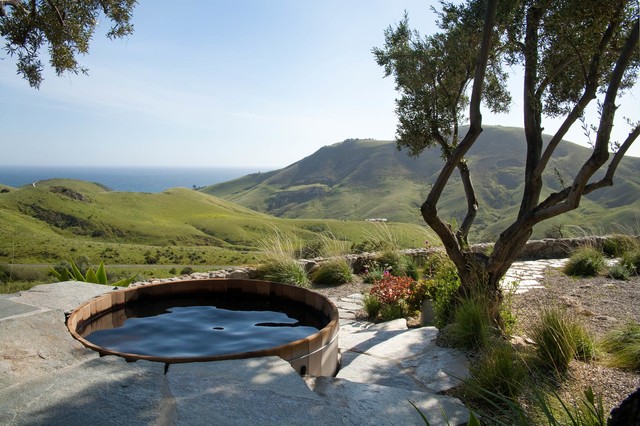
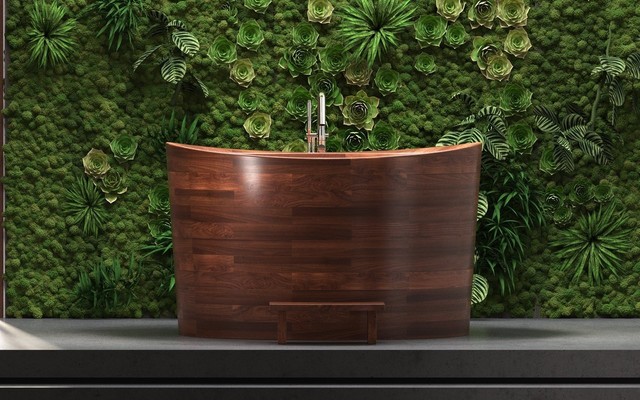
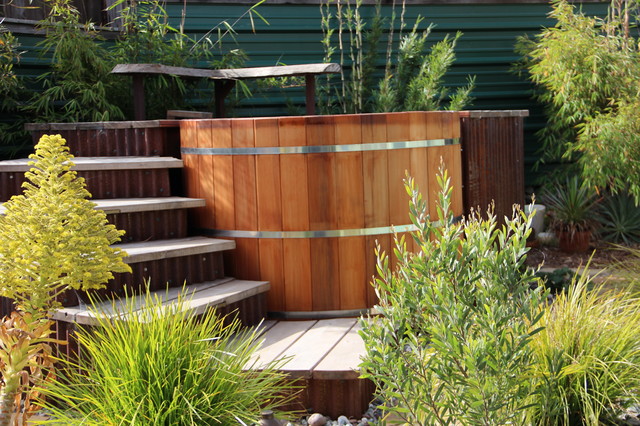
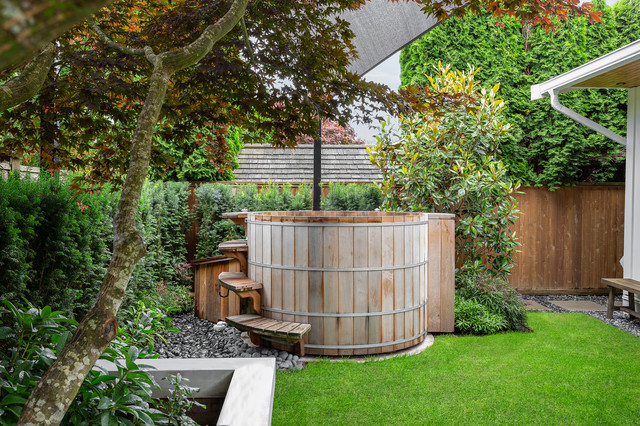

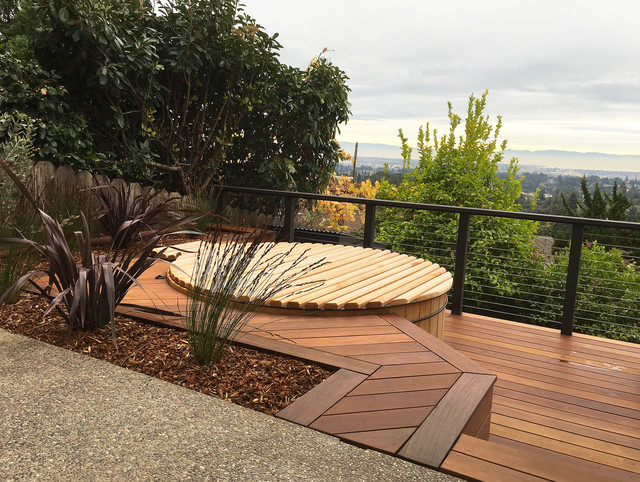
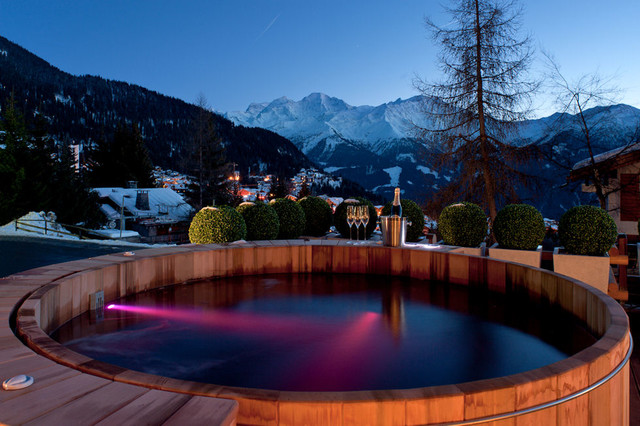
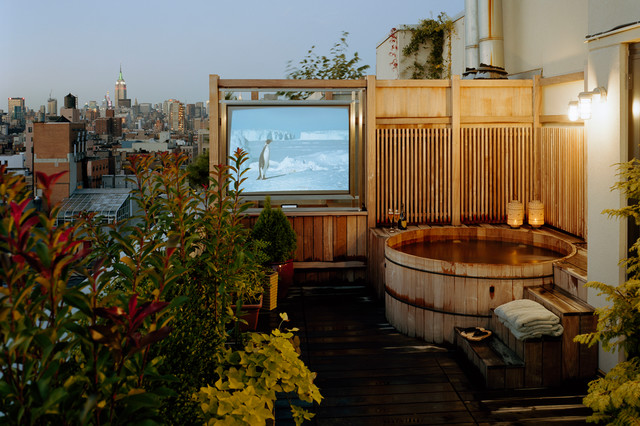
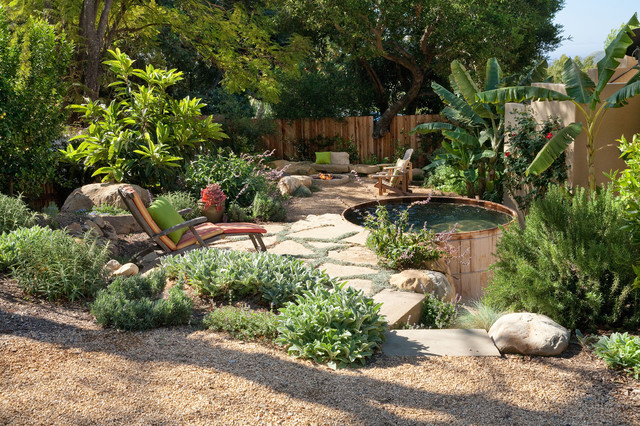
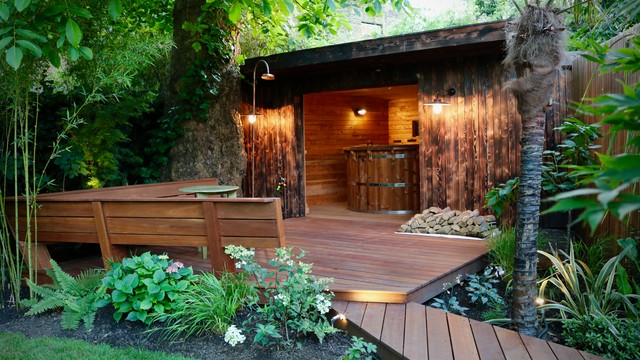
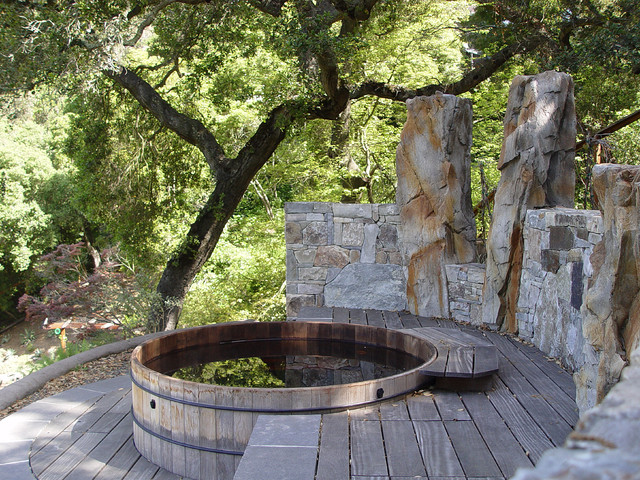
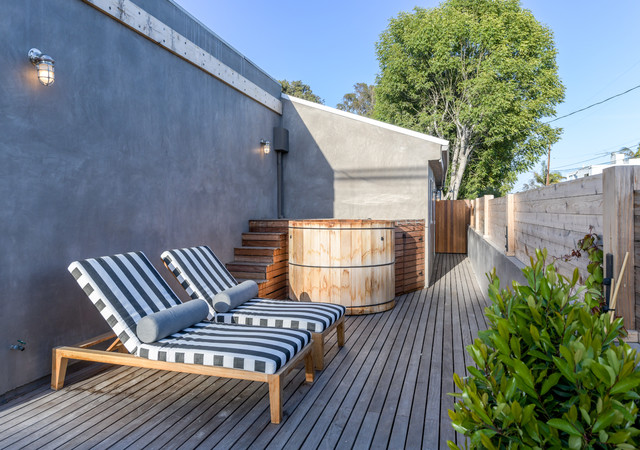

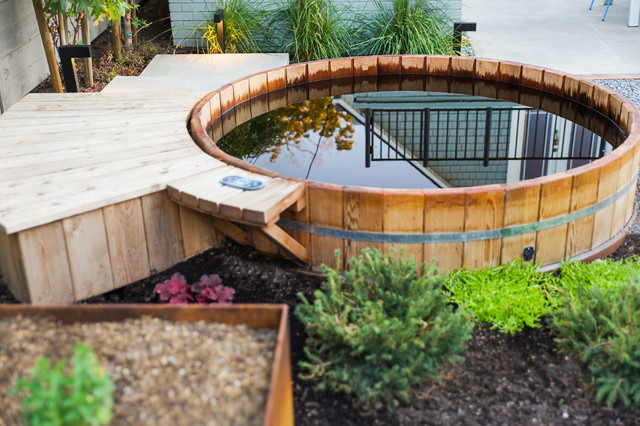
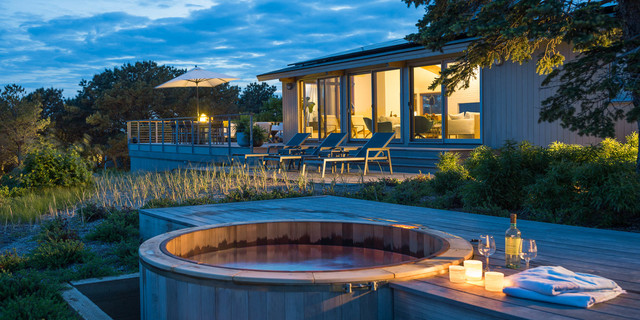
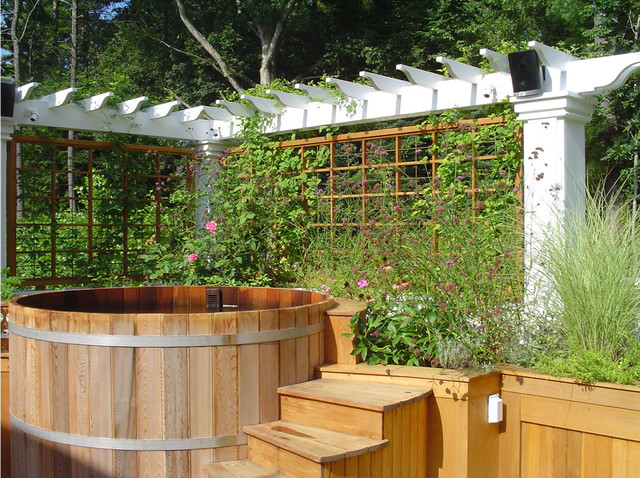
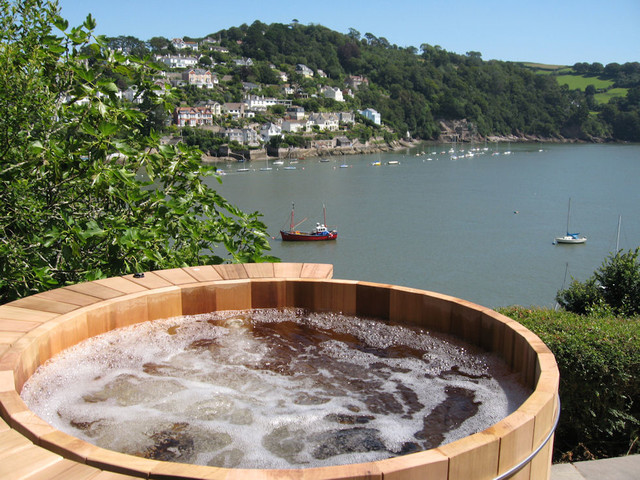
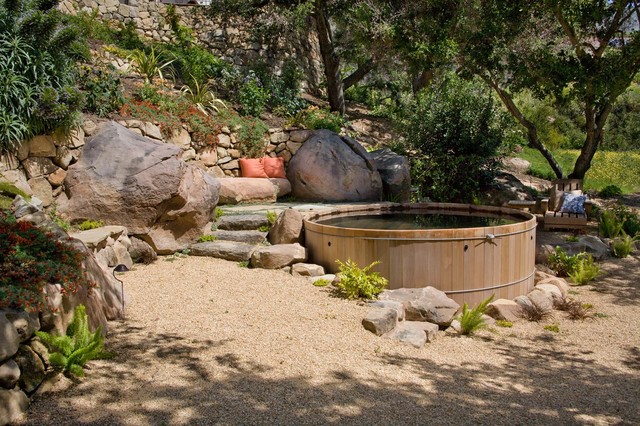
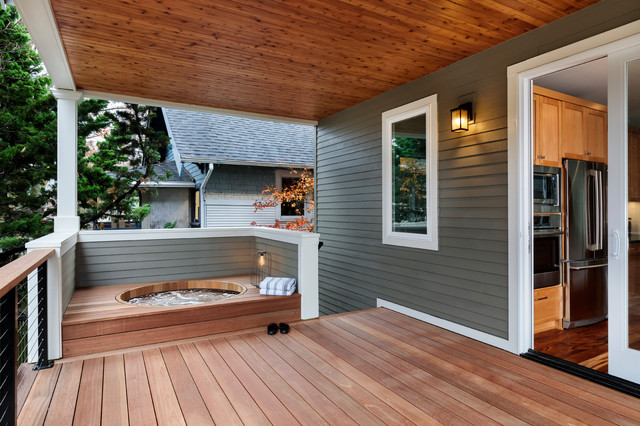
“I use these tubs because I find them more humane and naturalistic than the much more common molded plastic options,” says architect Michael Howells of Howells Architecture + Design in Portland, Oregon. He adds that the dark finish and lack of an interior light allow the water to read as much darker and more like it is in nature. “They are more pond-like…simple and reductive,” he says.
Though hot tubs are, by definition, filled with hot water, it’s not a requirement. Many people transform their hot tubs to “cool” tubs by not heating the water and instead enjoying the cooler water temperature on hot summer days. If you want it even colder, you can add a chiller element.